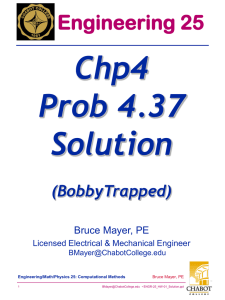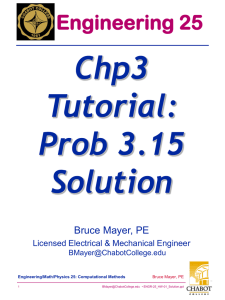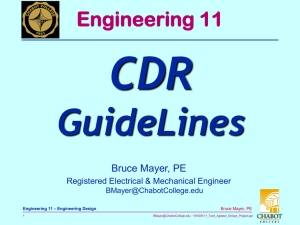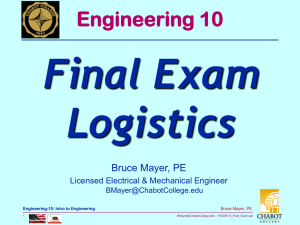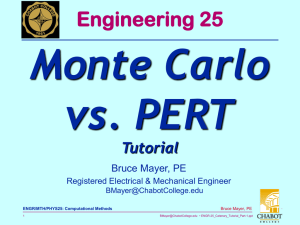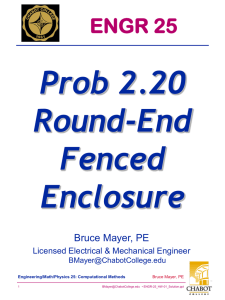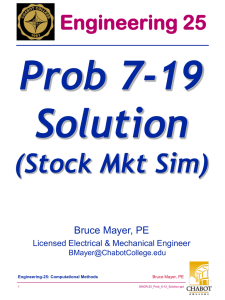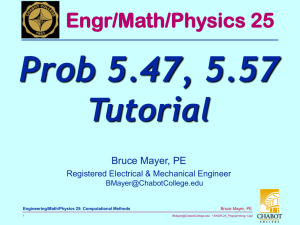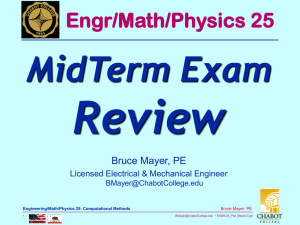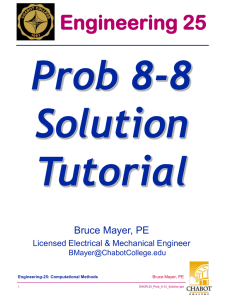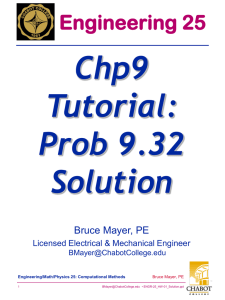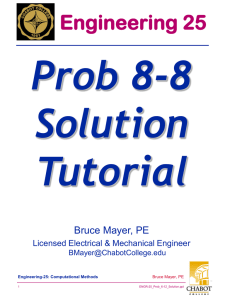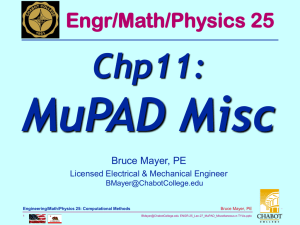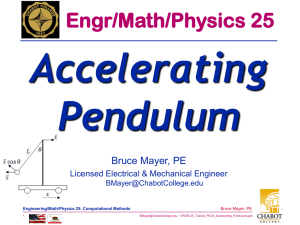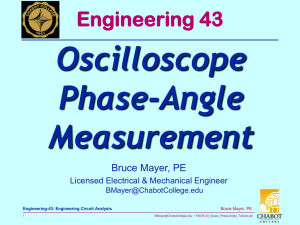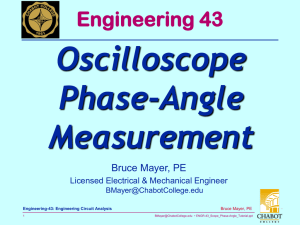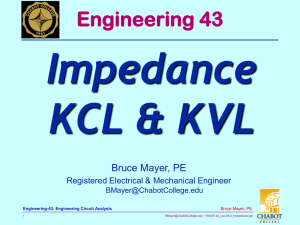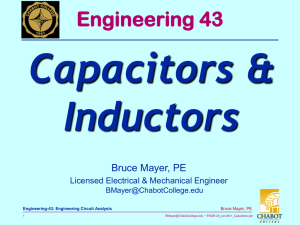Prob 6.18 Chem Rcn Rate Engr/Math/Physics 25 Bruce Mayer, PE
advertisement
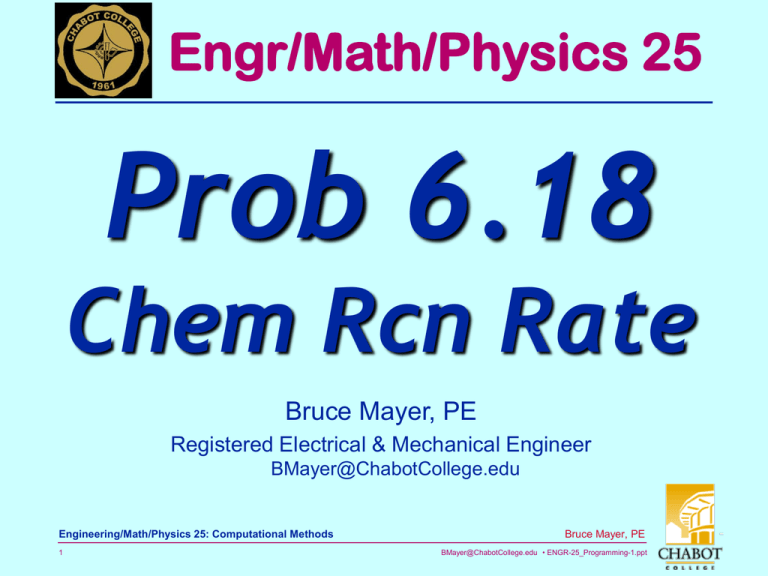
Engr/Math/Physics 25
Prob 6.18
Chem Rcn Rate
Bruce Mayer, PE
Registered Electrical & Mechanical Engineer
BMayer@ChabotCollege.edu
Engineering/Math/Physics 25: Computational Methods
1
Bruce Mayer, PE
BMayer@ChabotCollege.edu • ENGR-25_Programming-1.ppt
More Linear TransForms
These are NOT the Only Functional
Relationships that can be Linearized:
m
mx
pwr
exp
y
bx
y
be
ANY Function with exactly TWO fitting
Parameters is a Candidate for
Linearization
• e.g.; recall the
Clayeron Eqn
Engineering/Math/Physics 25: Computational Methods
2
Pv
ln
P
v ,ref
m 1 b
T
Bruce Mayer, PE
BMayer@ChabotCollege.edu • ENGR-25_Programming-1.ppt
Problem 6.18 Chemical Rcn Order
1st Order Rate Eqn is Expontnential
C t C 0 e
kt
y be
mx
• By SemiLog Linearization we can “Discover”
parameters [m & b] [−k & C(0)]
1
1
2nd Order Eqn can
kt
be LINEARIZED as C t
C 0
• Thus ANOTHER
Linearizable Fcn
1 y mx 1 b
Engineering/Math/Physics 25: Computational Methods
3
Y2 mX 2 B2
Bruce Mayer, PE
BMayer@ChabotCollege.edu • ENGR-25_Programming-1.ppt
Prob Solve 1st Step → PLOT it
Advice for Every Engineer and Applied
Mathematician or Physicist:
Rule-1: When in Doubt
PLOT IT!
Rule-2: If you don’t KNOW
when to DOUBT, then PLOT
EVERYTHING
Engineering/Math/Physics 25: Computational Methods
4
Bruce Mayer, PE
BMayer@ChabotCollege.edu • ENGR-25_Programming-1.ppt
The Concentration vs Time Data
For NitrousOxide Decomposition
2 NO2 2 NO O2
3
Time, t (s) C (mol/L) C (mol/m )
0
0.0100
10.0
50
0.0079
7.90
100
0.0065
6.50
200
0.0048
4.80
300
0.0038
3.80
Engineering/Math/Physics 25: Computational Methods
5
Bruce Mayer, PE
BMayer@ChabotCollege.edu • ENGR-25_Programming-1.ppt
The Data Bar Charted
Prob 6.18
Data
10
9
8
C (mol/m 3)
7
6
5
4
3
2
1
0
0
50
100
200
300
Time (s)
Engineering/Math/Physics 25: Computational Methods
6
Bruce Mayer, PE
BMayer@ChabotCollege.edu • ENGR-25_Programming-1.ppt
Prob 6.18
When in Doubt PLOT (use SubPlot)
1st Ord => ln(C)
-4.6
Some
CURVATURE
-4.8
-5
-5.2
-5.4
-5.6
0
50
100
150
t
200
250
300
2nd Ord =>1/C
300
Straight
250
• Better Model
• t X
• 1/C Y
200
150
100
0
50
100
150
t
Engineering/Math/Physics 25: Computational Methods
7
200
250
300
Bruce Mayer, PE
BMayer@ChabotCollege.edu • ENGR-25_Programming-1.ppt
Linear Xform of 2nd Order Reaction
Now that the plot
has identified the
Rcn as 2nd Order,
Make Linear Xform
The 2nd Order Eqn
1
1
kt
C t
C 0
Y2 mX 2 B2
Engineering/Math/Physics 25: Computational Methods
8
Use polyfit of
order-1 to generate
fitting parameters
contained in vector
k_1overC0
That is: k_1overC0
= [m, B2]; or
• k_1overC0(1)
=m→k
• k_1overC0(2)
= B2 → 1/C(0)
Bruce Mayer, PE
BMayer@ChabotCollege.edu • ENGR-25_Programming-1.ppt
9
The 2nd Order Model
% Bruce Mayer, PE * 11Mar12
% ENGR25
% file = Prob6_18_Chem_Concentration_1203.m
%
% CLEAR out any previous runs
clear
%
% The Data Vectors
t = [0,50,100,200,300]; % time in Sec
C = [0.01,0.0079,0.0065,0.0048,0.0038]; % Concen in mol/L
%
% WHEN IN DOUBT => PLOT
%* in this plot vs t to reveal Rch Order: ln(C) & 1/C
%** the Xformed DataVectors for RCN ORDER
Cfirst = log(C);
Csecond = 1./C;
%
% Check which one gives straight line
subplot(2,1,1)
plot(t,Cfirst,t,Cfirst,'*'), xlabel('t'), ylabel('1st Ord => ln(C)'),
grid
subplot(2,1,2)
plot(t,Csecond,t,Csecond,'o'), xlabel('t'), ylabel('2nd Ord =>1/C'),
grid
%
% After Comparing two curves, 2nd order gives much straighter line
%* use PolyFit to fit to 1/C(t)= k*t + 1/C0
%* Xform to Line => 1/C => Y, t => X, k => m, 1/C0 =>b
% Calc k & C0 showing in scientific notation
format short e
k_1overC0 = polyfit(t,Csecond,1)
k = k_1overC0(1)
C0 = 1/k_1overC0(2)
%
% Calc Cfit using 300 pts for smooth curve
tFit = linspace(0,300,300);
Cfit = 1./(k*tFit +1/C0);
%
disp('CLOSE Figure window, then hit any key to Continue')
pause
%
% Plot Data and fit. Put date in mol/cubic-meter
plot(t, 1000*C, 'd', tFit, 1000*Cfit, 'LineWidth', 2),xlabel('t
(s)'),...
ylabel('C (mol/m^3)'), grid, legend('Data', 'Curve Fit')
Engineering/Math/Physics 25: Computational Methods
Bruce Mayer, PE
BMayer@ChabotCollege.edu • ENGR-25_Programming-1.ppt
P 6.18 Answer
k_1overC0 = [m B2] = [k 1/C0] =
[5.4445e-001 9.9605e+001]
k = 5.4445e-001
• k = 0.54445/(L/mol∙sec)
C0 =
1/9.9605e+001
1.0040e-002
2 NO2 2 NO O2
1
1
kt
C t
C0
• C(0) = 0.01004 mol/Liter
Engineering/Math/Physics 25: Computational Methods
10
Bruce Mayer, PE
BMayer@ChabotCollege.edu • ENGR-25_Programming-1.ppt
Compare Data to Fit
11
Data
Curve Fit
10
9
C (mol/m3)
8
7
6
5
4
3
0
50
100
150
200
250
t (s)
Engineering/Math/Physics 25: Computational Methods
11
Bruce Mayer, PE
BMayer@ChabotCollege.edu • ENGR-25_Programming-1.ppt
300

